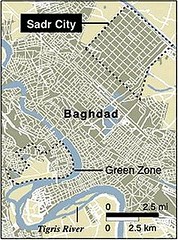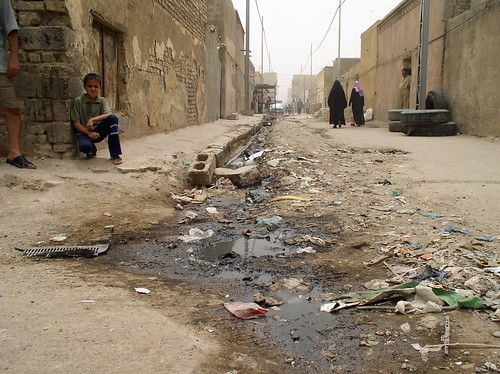Urbanism in Baghdad: rebuilding Sadr City

Posted February 11, 2010 at 1:39PM
I honestly don’t know what to think of this, so for now I’ll just report it: Aseel Kami writes on Reuters that “the city of Baghdad asked foreign companies [last month] to sign up for a project to design and build 75,000 apartments, the first phase of a $10 billion plan to rebuild the Iraqi capital's sprawling Sadr City slum.”
If all phases are built as contemplated, the project will cover 22 square miles (14,000 acres) and take over 10 years to implement. When completed, it will comprise 150,000 apartments as well as a university, a medical center, shops, parks and theaters.
 The challenge is formidable. As Kami’s article puts it, “Many buildings in Sadr City, a crowded Shi'ite area of up to 3 million people adjacent to an oilfield, have been reduced to rubble by U.S. air strikes. Electric power is sporadic, water is brought in by truck and the poorest residents live in shelters improvised from scavenged materials.” That’s rough.
The challenge is formidable. As Kami’s article puts it, “Many buildings in Sadr City, a crowded Shi'ite area of up to 3 million people adjacent to an oilfield, have been reduced to rubble by U.S. air strikes. Electric power is sporadic, water is brought in by truck and the poorest residents live in shelters improvised from scavenged materials.” That’s rough.
The government invited participation from foreign companies, and has awarded a design contract for the first phase to British architects Broadway Malyan. No designs or details have been posted online. In a comment posted on the website of The Architects’ Journal, Daniel Hewitt suggests that the use of western firms for the work is something to be considered with sensitivity for the plight of the Iraqi people, and that point would seem to be well taken.
I did some research on Sadr City for this post. Even before the US invasion, the area (then called Saddam City) housed many more people than its infrastructure could support, and there are many press reports of breakdowns in sewers and other systems. Now there is much more destruction, of course. There has been a serious shortage of potable water, which one hopes will be alleviated somewhat by a new water treatment plant built by the US Army. I found two very good in-depth articles, one by Michael Totten for his own site, and one by David Enders for the Virginia Quarterly Review; both are filled with insight.
It’s a complicated place, and one can only imagine the environmental issues. There is obviously much work to be done there. Will this massive project turn out to be the right approach? We’ll see.
